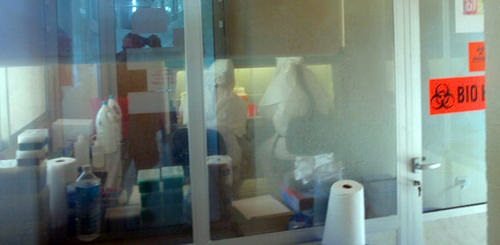
October 13, 2014; Washington Post
RoseAnn DeMoro, the executive director of National Nurses United, in a Washington Post op-ed, offered a truly important observation in two succinct, powerful paragraphs about America’s readiness to fight Ebola here:
“Ebola is exposing a broader problem: the sober reality of our fragmented, uncoordinated private health-care system. We have enormous health-care resources in the United States. What we lack is a national, integrated system needed to respond effectively to a severe national threat such as Ebola.
“The Centers for Disease Control and Prevention issues guidelines but has no authority to enforce them. Hospitals have wide latitude to pick and choose what protocols they will follow; too often in a corporate medical system those decisions are based on budget priorities, not what is best for the health and safety of patients and caregivers. Congress and state lawmakers put few mandates on what hospitals must do in the face of pandemics or other emergencies, and local health officials do not have the authority to direct procedures and protocols at hospitals.”
Where do nonprofits have stakes in this fragmented healthcare system? All over it. Everywhere. Among the 4,999 community hospitals in the U.S., well over half, 2,894, are owned by nonprofits, and another 1,037 are state and local government community hospitals. The Department of Health and Human Services has given grants to 1,278 health center grantees that operate 9,739 health center sites, undoubtedly the vast majority run by nonprofits (for-profits are not eligible). The Kaiser Family Foundation reports that there are another 100 “look-alikes” that offer services roughly equivalent to federally qualified health centers but do not receive federal grant support. Because of the coverage gaps in this system, there are also another 1,200 or so “free and charitable” clinics in the U.S. staffed by volunteer doctors, nurses, dentists, and other healthcare workers.
The fragmentation even exists within hospitals themselves. In the wake of the Ebola diagnosis of a second nurse at Texas Health Presbyterian Hospital, where Thomas Eric Duncan was treated after arriving from Liberia, National Nurses United, in a statement based on interviews with Texas Presbyterian nurses, charged that the hospital wasn’t sure about which protocols health workers should follow. (The CDC actually has two, and they don’t totally match.) The hospital left Duncan for hours in an area where other patients were present until a nurse supervisor intervened and demanded that Duncan be moved to an isolation unit—despite opposition from hospital administrators. Fully protective clothing for the nurses wasn’t available at the hospital, and nurses were told to cover exposed body areas (such as their necks) with medical tape that was clearly not impermeable. Duncan’s medical waste piled up, with no one to remove it.
Sign up for our free newsletters
Subscribe to NPQ's newsletters to have our top stories delivered directly to your inbox.
By signing up, you agree to our privacy policy and terms of use, and to receive messages from NPQ and our partners.
In a non-response response to the NNU statement, a hospital spokesperson said that the hospital offers annual training, maintains a 24-7 hotline, and provides a mechanism for anonymous reporting. The disconnect between the immediate specifics of the NNU charges and the hospital’s statement about annual training highlights intra-hospital fragmentation between frontline nurses and less-than-frontline hospital administrators.
Harvard University health economics and policy professor Meredith Rosenthal has characterized fragmentation as “the defining characteristic of the U.S. health care system.” In a prescient foreword to his edited volume on U.S. healthcare fragmentation, Einer Elhauge offered this pre-Ebola analysis in 2010:
“Looking at the most narrow dimension, we might be concerned about fragmentation in treating particular illnesses, such as the lack of coordination among the various professionals involved in treating a patient during a single hospital stay. This might occur if, for example, a patient tells one nurse she is allergic to some medicine, but the nurse does not communicate this information, so the nurse on the next shift administers that medicine. A somewhat broader conception would focus on fragmentation in treatments for particular patients at any give [sic] time, such as a lack of coordination between different providers that a patient might see for different illnesses.”
Elhauge’s most devastating statement sounded matter-of-fact:
“Given that we are talking about medicine, it makes sense to begin by asking: are there sound medical or scientific reasons for the current fragmentation of U.S. health care? Certainly none that appeared in any of the chapters of this book.”
In a footnote, Elhauge noted the possible interchangeability of the terms “fragmentation” and “disintegration.”
There is one more dimension to the fragmentation picture that makes combatting Ebola so difficult—the fragmentation of the healthcare workforce. The U.S. Health Workforce Chartbook counted 861,000 doctors and over 2.8 million registered nurses, but also 845,000 people employed as medical assistants and in other healthcare support occupations, over 1 million personal care aides, and more than 2.3 million nursing, psychiatric, and home health aides. Who is watching out for the lower paid healthcare personnel—and other people—who handle the “nastier aspects” of cleanup, like the striking Delta Air Lines contract workers who are brought in to clean up airplane cabins without the kinds of protective gear that might be needed to protect themselves from substances that could contain Ebola? The nation’s attention has gone from physicians such as Dr. Kent Brantly, who contracted Ebola while treating victims in West Africa, to nurses such as Dallas nurses Nina Pham and Amber Vinson, but who will be focusing on the other lower paid, often ill-treated health care staff who may be just as vulnerable if not more.
The union that typically represents workers like the striking cabin cleaners at LaGuardia, the Service Employees International Union, is often the union representing the assistants, aides, and other low-paid workers at hospitals whose responsibilities can include cleaning up hospital rooms and collecting and disposing of materials that could be hazardous. SEIU is distributing information on Ebola to its members, but if RNs are complaining that their hospitals are not convening them for education, training, and guidance for dealing with Ebola, what kinds of information might be given (or not) to hospital staff, who are paid much less than doctors and nurses? A nonprofit convening to address the fragmentation of the healthcare system has been warranted for a long time, but Ebola brings the issue into sharp relief. Nonprofits shouldn’t cower in panic, but they should be taking advantage of this health crisis to compel the nation to do what should have been done all along to improve healthcare delivery.—Rick Cohen











